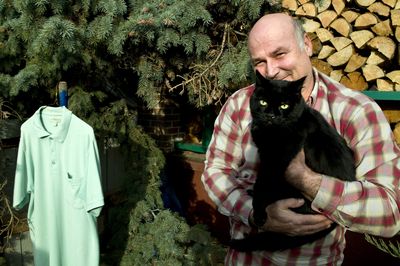Coyotes more common
Neighbors in urban Spokane settings fear for pets

It was 4 a.m., and Steve James was sitting on his couch in his little bungalow near Audubon Park. He works nights, so this is not an unusual situation for James. What happened next is getting to be more and more common, too, he said.
James heard yipping and growling and what sounded like a cat meowing, and went outside to investigate. He was met with the horrific sight of three coyotes pulling a cat apart on the lawn between his house and a neighbor’s, just a few steps from his front door.
“The cat was still dying. It was a really neat cream-colored cat,” said James. “The coyotes ran off and I jumped into the car and wanted to track them and scare them away.” From his home on West Dalton and Lindeke, James caught up with the three coyotes on West Milton.
“By then they had gotten another cat,” he said, “and when they saw me they just ran into a backyard and sat there and looked at me. They aren’t afraid at all.”
Wildlife and animal control agencies agree that urban coyotes are common across Spokane.
“I don’t think people realize that there are also coyotes making a living on the Seattle waterfront, right in the middle of downtown Seattle,” said Madonna Luers, public information officer for the Washington Department of Fish and Wildlife. “They are very adaptable, they are survivors, and we hear about them all the time.”
James found out the cream-colored cat was the 8-month-old kitten, Nicky, who belonged to Vivian Ryan and Shari Bankowski, who live on West Liberty and Lindeke, near James’ house.
“He must have gone prowling early in the morning,” Ryan said, tearing up. “Nicky was named after my grandson. He had Siamese coloring, with big blue eyes. He was very smart.”
It was James who delivered the sad news to Bankowski when she was outside raking leaves.
“Shari brought him home in a towel, and we buried him here in the yard,” Ryan said.
This is the second cat Ryan has lost in about a year. Of the other one, only the collar was found by a woman taking a walk in Audubon Park.
Luers said cats are common coyote prey.
“Coyotes learn very quickly that cats can be a quick meal,” Luers said. “Control your pets, especially cats and small dogs. Think of what attracts coyotes to your neighborhood – the first thing is usually food.”
Garbage should be covered and secured, and pet food should never be left outside, she said.
“We are sure there are people who feed (coyotes),” Luers said. “For many wild animals, on initial contact, most people say, ‘Oh, isn’t that cool?’ But you need to establish that near humans is not a place to be a wild animal.”
Luers said the best thing to do when you encounter a coyote is to yell at it, throw rocks at it, do anything you can think of to scare it away.
“You have got to establish that this is your territory, so to speak,” Luers said.
James said he’s seen packs of coyotes so brazen they come all the way up to people’s front porches.
Those packs are likely coyote families with half-grown pups that were born this spring, said Luers, adding that coyotes usually hunt alone.
James’ wife, Carol James, said she worries about children getting attacked.
“I hang on to my grandkids really tightly when we walk out to the car,” she said.
Up until 2006, when two toddlers were attacked by coyotes on the West Side of the state, there were no reported attacks on people in Washington, Luers said.
“Those were coyotes that had been fed by people. They were very brazen,” she said. “There is no need to panic about this, but of course you need to be careful about small children if you encounter a coyote.”
Steve James thinks some of the animals his neighbors have spotted are gray wolves, but Luers said that’s unlikely in an urban setting.
“Wolves are very shy around people,” she said. “But they’ve been in the news a lot, and every time that happens to a species, people tend to see that species all over the place.”
Jefferey Knudtson, another neighbor on James’ street, said coyotes try to get at his pet ducks.
“I would like for the coyotes to be taken out of here. This is not a wildlife preserve; this is an old established neighborhood,” Knudtson said. “It seems like the population has grown. I don’t think people understand what predators they are. They aren’t just cute wild dogs.”
Hunting season is open on coyotes year-round, but that’s a moot point within city limits because firearms can’t be discharged.
Luers said the best recourse people have if there are specific coyotes causing problems is to call a licensed wildlife control company.
“We simply don’t have the staff to deal with this,” she said. “Calling a company of course involves a fee. In rural areas the Department of Agriculture may come out and deal with them, but that’s because they make a dent in a livelihood by eating livestock.”
Carol James remains unsure about what should be done.
“I want them out of here, too,” she said, “but part of me feels sorry for them. They are beautiful animals.”